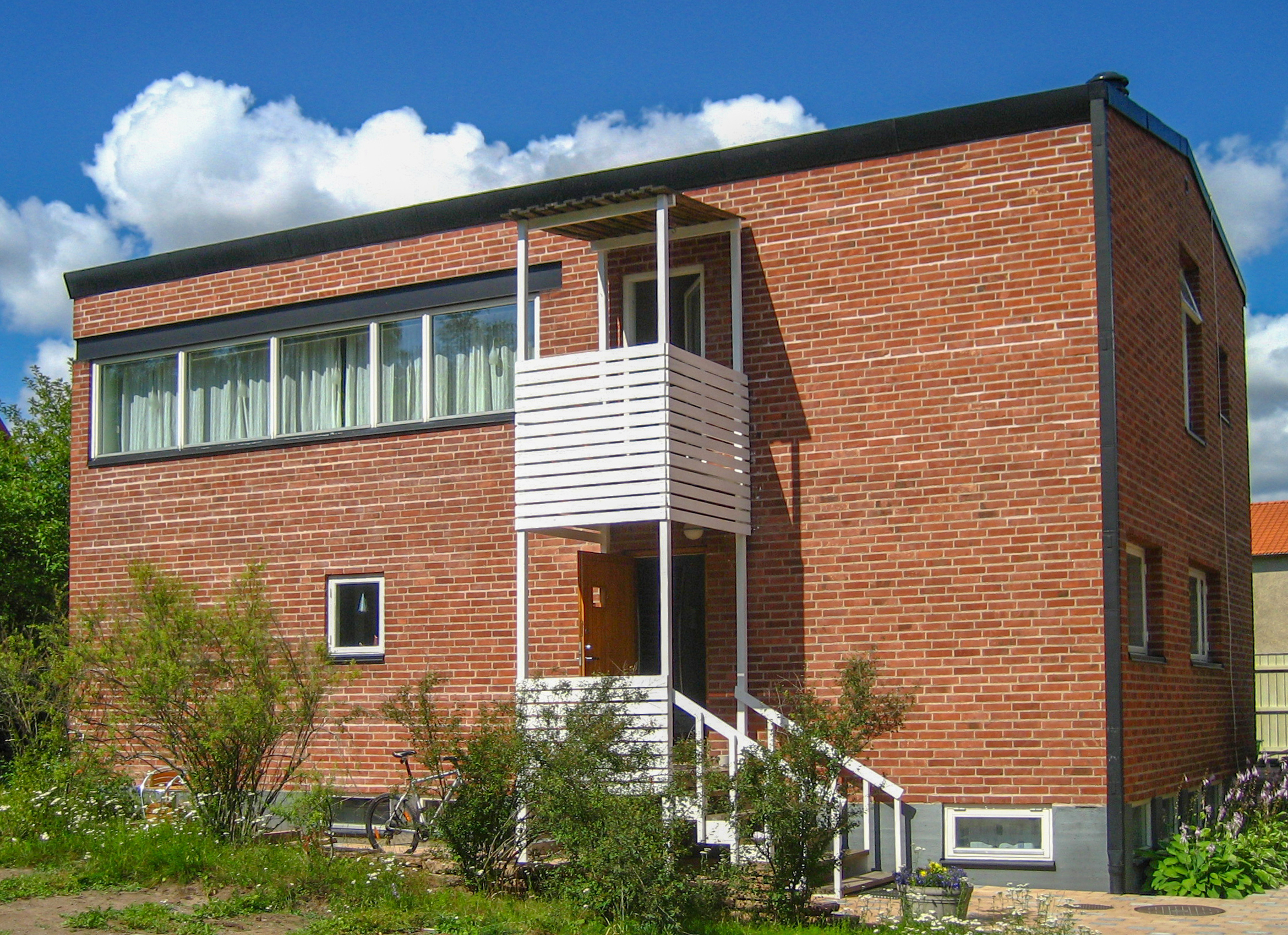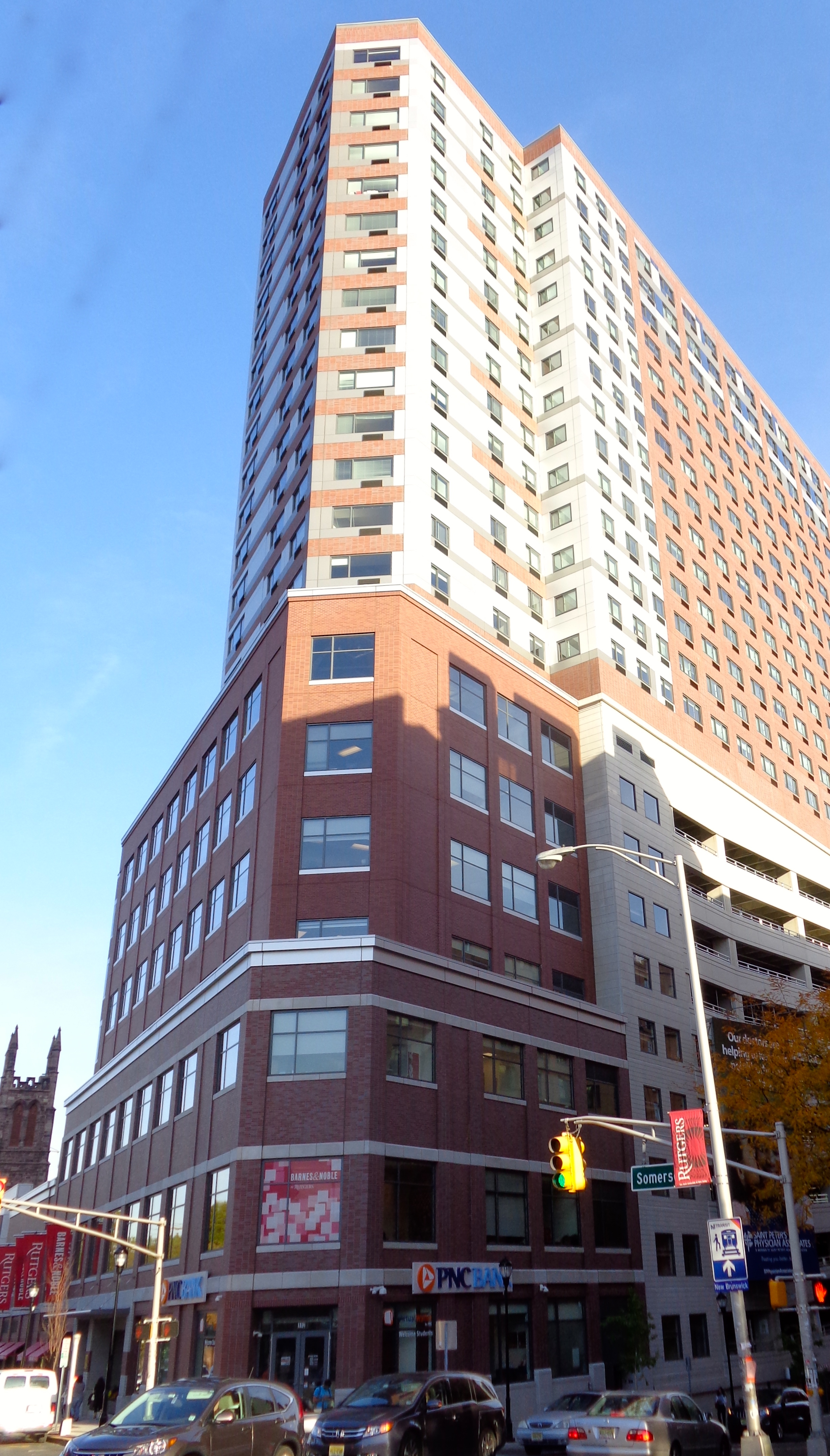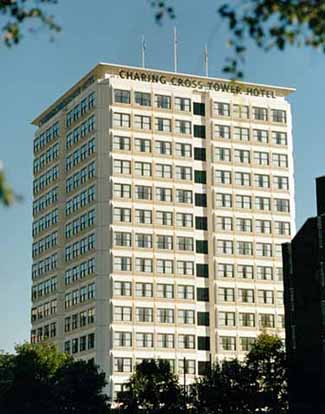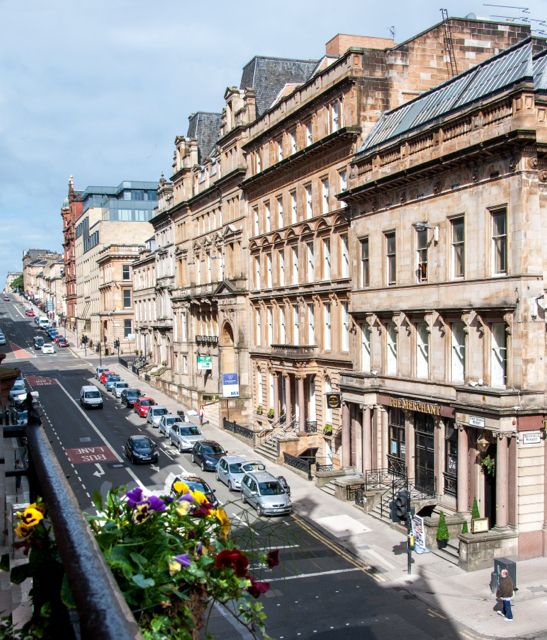|
Anderston Centre
The Anderston Centre (originally styled as the Anderston Cross Commercial Centre, but now officially branded as Cadogan Square) is a mixed-use commercial and residential complex, and former bus station located in the Anderston area of Glasgow, Scotland. Completed in 1972 and designed by Richard Seifert (best known for London's famous Centre Point and NatWest Tower), it is one of the earliest examples of the "megastructure" style of urban renewal scheme fashionable in the 1950s and 1960s - the other notable example in Scotland being the infamous Cumbernauld Town Centre development. The complex is a notable landmark on the western edge of Glasgow city centre, and is highly visible from the adjacent Kingston Bridge. The complex was voted at Position No. 54 in the Prospect magazine's 100 best modern Scottish buildings. After falling into partial dereliction in the 1990s, the megastructure has undergone major redevelopment with some elements demolished and replaced, and others ... [...More Info...] [...Related Items...] OR: [Wikipedia] [Google] [Baidu] |
Brutalism
Brutalist architecture is an architectural style that emerged during the 1950s in the United Kingdom, among the reconstruction projects of the post-war era. Brutalist buildings are characterised by minimalist constructions that showcase the bare building materials and structural elements over decorative design. The style commonly makes use of exposed, unpainted concrete or brick, angular geometric shapes and a predominantly monochrome colour palette; other materials, such as steel, timber, and glass, are also featured. Descending from the modernist movement, Brutalism is said to be a reaction against the nostalgia of architecture in the 1940s. Derived from the Swedish phrase ''nybrutalism,'' the term "New Brutalism" was first used by British architects Alison and Peter Smithson for their pioneering approach to design. The style was further popularised in a 1955 essay by architectural critic Reyner Banham, who also associated the movement with the French phrases ''bét ... [...More Info...] [...Related Items...] OR: [Wikipedia] [Google] [Baidu] |
Deindustrialization
Deindustrialization is a process of social and economic change caused by the removal or reduction of productive capacity, industrial capacity or activity in a country or region, especially of heavy industry or manufacturing industry. There are different interpretations of what deindustrialization is. Many associate Deindustrialization by country#United States, American deindustrialization with the mass closing of automaker plants in the now so-called "Rust Belt" between 1980 and 1990. The US Federal Reserve raised interest and exchange rates beginning in 1979, and continuing until 1984, which automatically caused import prices to fall. Japan was rapidly expanding productivity during this time, and this decimated the US machine tool sector. A second wave of deindustrialization occurred between 2001 and 2009, culminating in the automotive industry crisis of 2008–2010, automaker bailout of GM and Chrysler. Research has pointed to investment in patents rather than in new capi ... [...More Info...] [...Related Items...] OR: [Wikipedia] [Google] [Baidu] |
M8 Bridge To Nowhere
Bridge to Nowhere is a nickname used to refer to various unfinished structures around the M8 motorway in the centre of Glasgow, Scotland. They were built in the 1960s as part of the Glasgow Inner Ring Road project but left incomplete for several years. One "bridge", at Charing Cross, was completed in the 1990s as an office block. The Anderston Footbridge, a pedestrian bridge south of St Patrick's church, was finally completed in 2013 as part of a walking and cycling route. A third "Bridge to Nowhere" was created in 2008 following the demolition of a hotel a few blocks away from the M8 but its remains were finally removed in 2017. Charing Cross Podium The structure officially called the Charing Cross Podium was always intended to have a development of some sort on the top level. However, the incomplete structure looked like a bridge and was often referred to as the 'Bridge to Nowhere'. When the western flank of the inner ring road was being prepared for tender in the mid-1960s ... [...More Info...] [...Related Items...] OR: [Wikipedia] [Google] [Baidu] |
Fire Station
__NOTOC__ A fire station (also called a fire house, fire hall, firemen's hall, or engine house) is a structure or other area for storing firefighting apparatuses such as fire engines and related vehicles, personal protective equipment, fire hoses and other specialized equipment. Fire stations frequently contain working and living space for the firefighters and support staff. In large US cities, fire stations are often named for the primary fire companies and apparatus housed there, such as "Ladder 49". Other fire stations are named based on the district, neighborhood, town or village where they are located, or given a number. Facilities A fire station will at a minimum have a garage for housing at least one fire engine. There will also be storage space for equipment, though the most important equipment is stored in the vehicle itself. The approaches to a fire station are often posted with warning signs, and there may be a traffic signal to stop or warn traffic when appar ... [...More Info...] [...Related Items...] OR: [Wikipedia] [Google] [Baidu] |
Tower Block
A tower block, high-rise, apartment tower, residential tower, apartment block, block of flats, or office tower is a tall building, as opposed to a low-rise building and is defined differently in terms of height depending on the jurisdiction. It is used as a residential, office building, or other functions including hotel, retail, or with multiple purposes combined. Residential high-rise buildings are also known in some varieties of English, such as British English, as tower blocks and may be referred to as MDUs, standing for multi-dwelling units. A very tall high-rise building is referred to as a skyscraper. High-rise buildings became possible to construct with the invention of the elevator (lift) and with less expensive, more abundant building materials. The materials used for the structural system of high-rise buildings are reinforced concrete and steel. Most North American-style skyscrapers have a steel frame, while residential blocks are usually constructed of con ... [...More Info...] [...Related Items...] OR: [Wikipedia] [Google] [Baidu] |
Travelator
A moving walkway, also known as an autowalk, moving pavement, moving sidewalk, people-mover, travolator, or travelator, is a slow-moving conveyor mechanism that transports people across a horizontal or inclined plane over a short to medium distance. Moving walkways can be used by standing or walking on them. They are often installed in pairs, one for each direction. History The first moving walkway debuted at the World's Columbian Exposition of 1893, in Chicago, Illinois, in the United States as ''The Great Wharf Moving Sidewalk'' and was designed by architect Joseph Lyman Silsbee. It had two different divisions: one where passengers were seated, and one where riders could stand or walk. It ran in a loop down the length of a lakefront pier to a casino. Six years later a moving walkway was also presented to the public at the 1900 Exposition Universelle in Paris as the ''Rue de l'Avenir''. The walkway consisted of three elevated platforms, the first was stationary, the second mo ... [...More Info...] [...Related Items...] OR: [Wikipedia] [Google] [Baidu] |
Escalator
An escalator is a moving staircase which carries people between floors of a building or structure. It consists of a motor-driven chain of individually linked steps on a track which cycle on a pair of tracks which keep the step tread horizontal. Escalators are often used around the world in places where lifts would be impractical, or they can be used in conjunction with them. Principal areas of usage include department stores, shopping malls, airports, transit systems (railway/railroad stations), convention centers, hotels, arenas, stadiums and public buildings. Escalators have the capacity to move large numbers of people. They have no waiting interval (except during very heavy traffic). They can be used to guide people toward main exits or special exhibits and may be weatherproofed for outdoor use. A non-functional escalator can function as a normal staircase, whereas many other methods of transport become useless when they break down or lose power. Design, component ... [...More Info...] [...Related Items...] OR: [Wikipedia] [Google] [Baidu] |
Premier Inn
Premier Inn is a British limited service hotel chain and the UK's largest hotel brand, with more than 72,000 rooms and 800 hotels. It operates hotels in a variety of locations including city centres, suburbs and airports competing with the likes of Travelodge and Ibis hotels. The company was established by Whitbread as Travel Inn in 1987, to compete with Travelodge. Whitbread bought Premier Lodge in 2004 and merged it with Travel Inn to form the current business under the name "Premier Travel Inn", which was then shortened to "Premier Inn" in 2007. Premier Inn accounts for 70% of Whitbread's earnings. History The chain started trading in 1987 as Travel Inn. The first site to open was next to "The Watermill" Beefeater restaurant in Basildon. In 2004, Whitbread acquired another hotel chain, Premier Lodge, for £536 million. This added 141 hotels to the portfolio. Whitbread renamed every hotel "Premier Travel Inn". In 2005, Premier Travel Inn opened its 500th hotel in Hem ... [...More Info...] [...Related Items...] OR: [Wikipedia] [Google] [Baidu] |
Charing Cross, Glasgow
Charing Cross is a major road junction in the Scottish city of Glasgow. It is situated north of the River Clyde at the intersection of Sauchiehall Street, St George's Road, Woodlands Road, North Street and Newton Street, as well as being at a major interchange of the M8 motorway. Taking its name originally from a block of tenements named Charing Cross Place built in the 1850s, which continue at the south-west corner with North Street, the junction of Sauchiehall Street was formed as part of the original development of Blythswood Hill including Blythswood Square, St George's Road and North Street becoming known as Charing Cross, linking the city centre and the new West End, commencing at Woodlands and Sandyford. Much of its architecture was destroyed when the motorway was built through it in the late 1960s, notably the Grand Hotel at its heart. It still marks the boundary between the City Centre and the West End of the city. There are ornate red sandstone tenement blocks ... [...More Info...] [...Related Items...] OR: [Wikipedia] [Google] [Baidu] |
Elmbank Gardens
The Charing Cross Complex - now styled as Elmbank Gardens (but sometimes popularly referred to as the Charing Cross Tower), is a multi-use commercial complex in the Charing Cross area of Glasgow, Scotland. Best known for its signature 14-storey tower which overlooks the M8 motorway and stands directly opposite the Mitchell Library, it was designed by Richard Seifert and constructed between 1969 and 1973. It is one of the tallest and most prominent high rise buildings on the western side of Glasgow city centre, beyond Blythswood Hill. The surface buildings of the subterranean railway station which serves Charing Cross are also an integral part of the complex. Since 1995, the tower element has been used as a hotel, whilst the remainder of the complex is home to offices and a number of other leisure and entertainment businesses. History The 1960s saw great change in Glasgow, following on from the Bruce Report with initiatives well under way to depopulate the overcrowded centre, r ... [...More Info...] [...Related Items...] OR: [Wikipedia] [Google] [Baidu] |
City Block
A city block, residential block, urban block, or simply block is a central element of urban planning and urban design. A city block is the smallest group of buildings that is surrounded by streets, not counting any type of thoroughfare within the area of a building or comparable structure. City blocks are the space for buildings within the street pattern of a city, and form the basic unit of a city's urban fabric. City blocks may be subdivided into any number of smaller land lots usually in private ownership, though in some cases, it may be other forms of tenure. City blocks are usually built-up to varying degrees and thus form the physical containers or "streetwalls" of public space. Most cities are composed of a greater or lesser variety of sizes and shapes of urban block. For example, many pre-industrial cores of cities in Europe, Asia, and the Middle East tend to have irregularly shaped street patterns and urban blocks, while cities based on grids have much more regular arr ... [...More Info...] [...Related Items...] OR: [Wikipedia] [Google] [Baidu] |
Blythswood Hill
Blythswood Hill, crowned by the elegance of Blythswood Square, is the wealthiest part of central Glasgow, Scotland. It extends from the west edge of Buchanan Street to Gordon Street and Bothwell Street, Charing Cross, Sauchiehall Street and Garnethill. Developed as the city's wealthiest and healthiest residential area from 1800 onwards, its Georgian and Victorian architecture continues as a Conservation Area of international note. It started as the "Magnificent New Town of Blythswood" becoming an integral part of the city-centre's business and social life. After the Reformation the vast Lands of Blythswood were owned by the distinguished Glasgow merchant family Elphinstone; one descendant George Elphinstone became an MP of the Scots Parliament. Through his daughter it changed to the Douglas-Campbell family during the 17th century. Archibald Campbell, whose son became Lord Blythswood, setting about feuing the lands to developers.''Glasgow Past and Present'', by Senex and ... [...More Info...] [...Related Items...] OR: [Wikipedia] [Google] [Baidu] |









